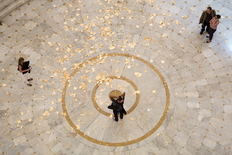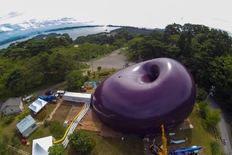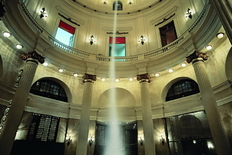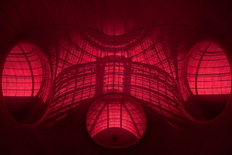Artist: Anish Kapoor
Client: Deutsche Guggenheim (GER)/
Solomon R. Guggenheim Foundation NY (USA)
Object: Steel shell structure
Project start: December 2007
Project delivery: November 2008
Anish Kapoor proposed the tourable installation of a large rusted Cor-Ten steel sculpture.
The sculpture was designed to fit precisely within the constraints of the Deutsche Guggenheim Berlin and the Guggenheim Museum in New York.
The sculpture is divided in 154 tiles, each of 8mm thickness. The tiles are bolted together through the raised pattern of stiffening ribs, which are visible on the outside of the form, to become a complete structure shell. The sculpture is assembled by bolting the tiles stiffeners. The darkened void of the inside is also made visible through a precisely square aperture approachable through an adjacent gallery.
During the reverse engineering process Aerotrope generated a 3D CAD model from the artist’s maquette. We worked closely with the artist in the form finding stage and after few form iterations and milling scaled down physical models we achieved the final form geometry.
The geometry and thickness of the stiffeners was calculated using FEA programs, employing methods more commonly applied to the shell structures of ships and aircrafts, whose so-called “monocoque” hull and fuselage structures behave in a similar way.
The artist’s vision was to achieve an apparent weightlessness of the form by having minimal glancing contacts with the floor, walls, and ceiling. The engineering design was further constrained by the location and number of the sculpture’ support points on the floor because those had to remain invisible to the public.
As mentioned, the sculpture was designed to comply with the floor beam arrangement and bearing capacity of two different galleries, one in Berlin and the other in New York.
All these issues presented great challenges for our engineers in order to accommodate the 24-tonnes sculpture in the galleries.
Aerotrope followed the fabrication process of the sculpture closely in order to guarantee the work met all structural and aesthetic requirements. We also provided on-site technical support during the sculpture’s installation, as the precise location and orientation of the first steel tiles was crucial so the sculpture would fit perfectly in the space without wall gaps or clashes.
An interview with Chris Hornzee-Jones by This Week in New York
Similar works engineered by Aerotrope: Hive (Royal Academy 2010), Lisson 2012











